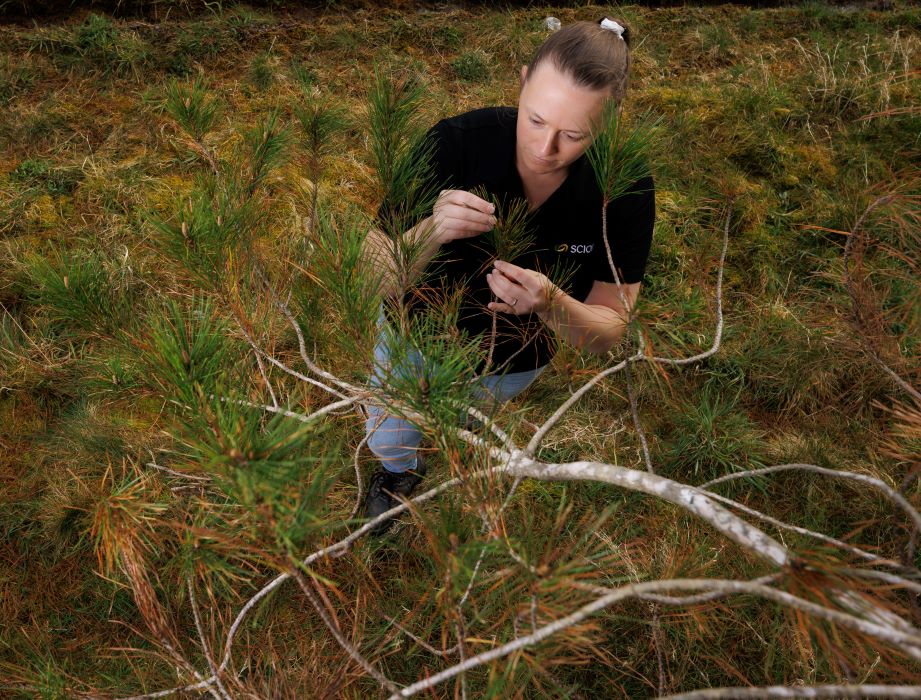Research wages war against a silent threat in our planted forests

For immediate release
10 October 2023
New research and smart technologies are offering hope and solutions to foresters waging war against a silent enemy in our pine plantations.
Red needle cast (RNC), an unyielding fungal-like disease, has silently been wreaking havoc on pine trees in New Zealand since at least 2008. Infections cause pine needles to lose their colour and fall to the ground, with research showing how defoliation can impact growth for three years after the trees show symptoms.
In response, scientists from Scion’s Resilient Forests Research Programme are at the forefront of the battle, with their work providing hope for forest growers striving to mitigate the combined impact of invasive pathogens and climate change’s impact on tree health.

Dr Stuart Fraser, leader of Scion’s Ecology and Environment research group, has dedicated more than six years to investigating the disease and potential control strategies. Joining him in 2021, forest pathologist Emily McLay is adding depth to the understanding of the disease, with research that aims to make it easier to predict when outbreaks will occur.
La Niña events impacting New Zealand in recent years have resulted in extreme wet conditions. This increased moisture has created a favourable environment for needle diseases, making them more widespread and persistent.
“We are in a new normal,” says McLay. “We used to believe in disease seasons, but recently, these seasons have become continuous due to the prolonged wet conditions. Normally, drier and hotter weather would interrupt the disease cycle, but with the persistent moisture, RNC has continued to thrive, contributing to this year’s severity.”


Satellite imagery of plantation forests on the East Coast, provided by Indufor, illustrates the extent of the disease this August compared with the same time one year ago.
Scientists say the key to combating RNC lies in deciphering the pathogen-host interaction and how the environment influences it. RNC completes its life cycle on the needles of radiata pine trees, and very quickly responds to environmental stimuli. McLay’s laboratory work is focused on understanding how temperature and moisture drive different processes in the disease cycle. “It’s a targeted study that we can use to build epidemiological models, so we can predict when these big years might happen,” she says.
“One of the challenging aspects about field trials is that there’s co-variation. Winter is typically colder and wetter, whereas summer is warmer and drier. When it comes to building a model, it’s really hard to pull those apart.”
Her research, therefore, focuses on teasing out the influence of temperature and wetness, shedding light on their distinct roles.
To help the forestry industry and Scion’s pathologists better understand the extent of RNC, Scion’s remote sensing and geospatial intelligence team provides monitoring support. Scientists are mapping the presence of the disease and are keen to hear from industry professionals with suspected sightings of RNC to better inform their model.
Team Lead Grant Pearse explains, “We use free, coarser resolution satellite imagery to identify areas that might have disease expression. But it can generate some false positives for various reasons.
“The presence of RNC can only be confirmed through the purchase of very high-resolution satellite imagery from a commercial provider for more detailed mapping. To use our commercial imagery budget efficiently and make our modelling more accurate, we’d love to hear more from industry about areas where RNC could be impacting forests. Having more accurate data means we’ll need to investigate fewer false positives long-term. Ideally, we are looking for larger areas of trees affected by RNC as satellites struggle to detect a few roadside trees, for example.”
As the RNC battle escalates, pragmatic solutions for industry are imperative, with copper emerging as a viable control treatment. Already used in low doses to manage Dothistroma needle blight, a disease akin to RNC, copper’s efficacy has been validated for more than 60 years. The Central North Island, considered a hotbed for Dothistroma, saw the first copper trials to control RNC in 2017, led by Dr Fraser.
Significant RNC outbreaks in 2015 and 2016 spurred Mike Baker, National Forestry Manager at Manulife Forest Management (NZ), to collaborate with Scion on large-scale copper trials. Trials in Kinleith Forest demonstrated that copper significantly curbed RNC’s severity.
These trials explored optimal spray timings for RNC control. However, a consistent pattern wasn’t evident. Despite this, disease severity decreased across all trial timings compared to unsprayed control. It's hoped copper trials on forests in the East Coast will shed more light on the effectiveness of copper under greater disease pressure.

With the Resilient Forests Research Programme developed to future proof planted radiata pine forests from the impact of climate change, McLay’s research is building towards the development of a prototype model to predict RNC disease outbreaks. Although a few years away from being commercially available, the tool’s aim is to empower foresters with information they can use to take pre-emptive action.
With satellite monitoring and copper research, a transformative disease management approach is emerging. “We’re aiming to not just respond to outbreaks, but foresee and address potential concerns,” says McLay.
Forest Growers’ Research chief executive Paul Adams says Scion’s research offers industry a beacon of hope for safeguarding New Zealand’s forests and sustaining the timber industry.
“It holds immense value for our forestry sector. The potential use of copper treatments is promising. Combined with the development of predictive models and satellite-based monitoring, these research efforts will help our future forests be more resilient in the face of climate change.”
ENDS
